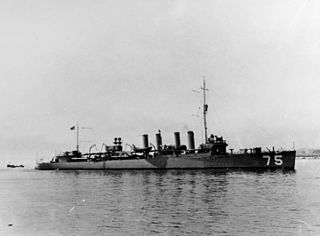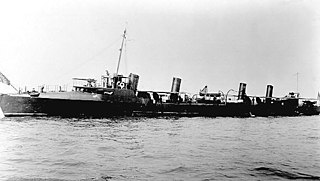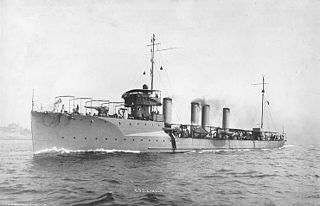
USS Jacob Jones (DD-130), named for Commodore Jacob Jones USN (1768–1850), was a Wickes-class destroyer. Jacob Jones was laid down by the New York Shipbuilding Corporation at Camden, New Jersey on 21 February 1918, launched on 20 November 1918 by Mrs. Cazenove Doughton, great-granddaughter of Commodore Jones and commissioned on 20 October 1919, Lieutenant Commander Paul H. Bastedo in command. She was sunk by a German submarine in 1942 during World War II.

USS Roper (DD-147) was a Wickes-class destroyer in the United States Navy, later converted to a high-speed transport and redesignated APD-20.

The first USS Wickes (DD-75) was the lead ship of her class of destroyers in the United States Navy during World War I, later transferred to the Royal Navy as HMS Montgomery. She has been the only ship of the Royal Navy to bear the name Montgomery.

The first USS Philip (DD–76) was a Wickes-class destroyer in the United States Navy during World War I, later transferred to the Royal Navy as HMS Lancaster. She was named for John Woodward Philip.

USS Robinson (DD-88) was a Wickes-class destroyer in the United States Navy, later transferred to the Royal Navy, as HMS Newmarket (G47). She was the first ship named for Isaiah Robinson.

USS Stribling (DD-96) was a Wickes-class destroyer in the United States Navy during World War I and the years following. She was the first ship named in honor of Cornelius Stribling.

USS Williams (DD-108) was a Wickes-class destroyer in the United States Navy entering service in 1919, and was the second ship to bear the name. Following a brief stint in active service, the ship was laid up for 17 years before being reactivated during World War II. Williams transferred to the Royal Canadian Navy during World War II as part of Lend-Lease and was renamed HMCS St. Clair (I65), surviving the war and being scrapped in 1946.

USS Galveston (C-17/PG-31/CL-19) was a Denver-class protected cruiser in the United States Navy during World War I. She was the first Navy ship named for the city of Galveston, Texas.

The second USS Truxtun (DD-14) was the lead ship of Truxtun-class destroyers in the United States Navy. She was named for Commodore Thomas Truxtun.

USS Lamson (DD–18) was a Smith-class destroyer in the United States Navy during World War I. She was the first ship named for Roswell Lamson.

USS Flusser (DD–20) was a Smith-class destroyer in the United States Navy during World War I. She was the second ship named for Lieutenant commander Charles W. Flusser.

The first USS Fanning (DD-37) was a modified Paulding-class destroyer in the United States Navy during World War I and later in the United States Coast Guard, designated as CG-11. Her namesake was Nathaniel Fanning.

USS Wilkes (DD-67) was a Sampson-class destroyer in the United States Navy during World War I. She was the second Navy ship named for Commodore Charles Wilkes (1798–1877). She served with the United States Coast Guard as (CG-25).
USS Dallas (DD-199) was a Clemson-class destroyer in the United States Navy during World War II. She was the second ship named for Captain Alexander J. Dallas, and was later renamed Alexander Dallas.

USS Goff (DD-247) was a Clemson-class destroyer in the United States Navy during World War II. She was named for Secretary of the Navy Nathan Goff, Jr.

USS Woolsey (DD-437), a Gleaves-class destroyer, was the second ship to be named Woolsey in the United States Navy. It is the first to be named for both Commodore Melancthon Brooks Woolsey and his father Commodore Melancthon Taylor Woolsey.

USS Warrington (DD-383) – a Somers-class destroyer – was the second ship of the United States Navy to be named for Lewis Warrington, who was an officer in the Navy during the Barbary Wars and the War of 1812. He also temporarily served as the Secretary of the Navy.

USS Wheeling (PG-14) was a Wheeling-class gunboat acquired by the U.S. Navy in 1897. She served as a gunboat during the Spanish–American War as well as a convoy escort during World War I. As IX-28 she also served as a schoolship for the training of Naval Reservists, and, at the end of World War II, just before being struck from the Navy records, she was temporarily assigned as a barracks ship for torpedo boat crews.

USS Sellstrom (DE-255) was an Edsall-class destroyer escort built for the U.S. Navy during World War II. She served in the Atlantic Ocean, the Pacific Ocean and provided destroyer escort protection against submarine and air attack for Navy vessels and convoys.

USS Dreadnaught (ID-1951), later YT-534 and YNG-21, was a United States Navy tug that was in service from 1918 to 1944.



















